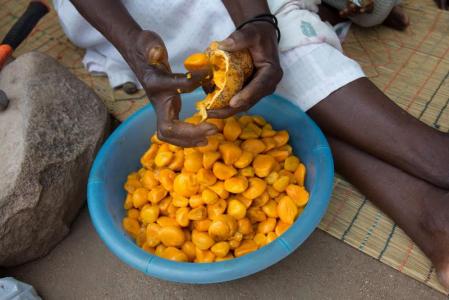Globally, about 842 million people are undernourished – about 12% of the population – and more than 2 billion suffer from micronutrient deficiency, or “hidden hunger,” according to the UN Food and Agriculture Organization (FAO). This is a great improvement from 20 years ago, when 19% of people in the world were going hungry. Yet as poverty declines, demand for food rises. With the global population expected to grow from 7 billion today to nearly 10 billion by 2050, demand for cropland will be ever-higher, intensifying the pressure to clear forests for agricultural expansion.
The irony is that – although further research is needed – several studies have suggested that forests play a key role in nutrition and food security. For example, a study of 21 African countries, using data from health surveys of 93,000 children aged 1-5, found that children living close to forested areas tended to have more nutritious diets and consumed more fruits and vegetables. At the World Congress on Agroforestry, which I am attending this week in New Delhi, a full session was devoted to exploring the links between tree cover and nutrition.
As part of the WCA session, the lead author of the African study, Amy Ickowitz, of the Center for International Forestry Research (CIFOR), presented a new analysis focused on Indonesia. She offered three reasons why tree cover might be linked to nutrition: First of all, children who live close to a forest are likely to have greater access to wild fruits, leafy greens and bushmeat – food that can provide them with important micronutrients such as vitamin A, iron and zinc. Second, households that are closer to an agroforestry system may have greater access to fruits and nuts. Third, people in heavily forested areas may plant a more complex mosaic of crops, which would result in more nutritious diets.
Tree cover may also be good for nutrition, Ickowitz said, because having access to non-timber forest products can have a positive effect on agriculture in the landscape, increasing productivity. The trees can also provide “back-up” food when other sources run low, and trees also provide fuelwood for cooking, an often-overlooked necessity for good nutrition.

We still have a great deal to learn. Although Ickowitz and other speakers at the WCA offered many compelling ideas, more research is needed to better understand the relationship between tree cover and nutrition: what are the key drivers, what kinds of trees and forests make the biggest difference, etc. These insights would be valuable additions to a growing body of knowledge about food production and nutrition, and support the development of more effective food and forestry policies alike.
A great deal of effort has gone into increasing the production of energy-rich staple crops such as rice, maize and wheat, but as the FAO’s State of Food and Agriculture 2013 stressed, that’s not enough. We need to broaden the focus to make improved nutrition a central goal in achieving food security – and that means more diverse diets, which forests and agroforestry can help provide. Another speaker at the WCA session, Katja Kehlenbeck, of the World Agroforestry Centre, presented research on the food security and nutritional impact of including fruit trees in agroforestry systems.
Malnutrition continues to be widespread in sub-Saharan Africa, and to a large extent, this has to do with low consumption of fruits and vegetables – only 27–114 kg/capita per year, well below the 146kg/year recommended by the World Health Organization (WHO). In that context, Kehlenbeck says, planting fruit trees can bring many benefits:
- Fruit trees can be harvested for a longer period of time over the year, and if practically planned, they can generate a year-round harvest. This is especially important for filling “the hunger gap” – the period just before the harvest of staple crops, when the food shortage is the largest.
- Planting fruit trees has a high potential for income generation, not only for the fresh fruit but also processed. This is especially important for women, who usually are in charge of the fruit trees.
- Fruit trees are more drought-tolerant than annual crops, which makes them especially suitable to enhance food security, to provide resilience as well as adaptation to climate change.
My colleague Jenny Friman has drawn similar conclusions from research in Burkina Faso. But there are also risks in encouraging farmers to plant fruit trees: if they plant large monocultures of fruit trees, for example, or turn agroforestry systems into intensive monocultures, biodiversity and ecosystem services may suffer; there might even be pressure to replace forests with fruit tree plantations. Kehlenbeck also highlighted the risks to livelihoods and food security, if farmers grow trees as a cash crop on land where they used to grow food for the household. This risky venture may be derailed by lack of market access, low prices, or a bad harvest.
The links between trees and nutrition are a crucial area of research, one that could have been discussed at much greater length at the WCA. As part of a collaborative project on the theme “Forests, Landscapes and Food Security”, my colleagues and I will continue to explore these issues; we hope you will join us in this endeavor and share your own perspectives.
Matilda Palm is a post-doctoral researcher in the Department of Energy and Environment, Chalmers University of Technology, and a member of the Forest, Climate & Livelihood Research Network (Focali). She is participating in the World Congress on Agroforestry as part of a collaboration between Focali and the Swedish International Agricultural Network Initiative (SIANI) around the theme ’Forests, Landscapes and Food Security’.
SIANI at the World Congress on Agroforestry: Focus on trees and food security
